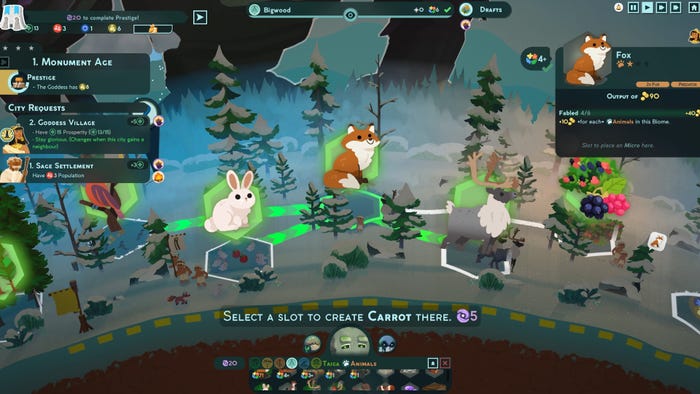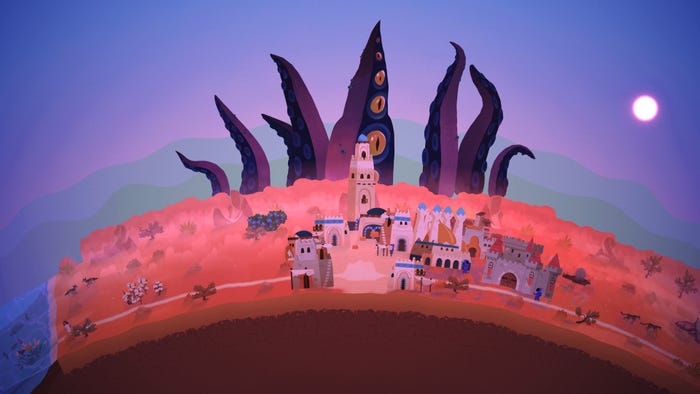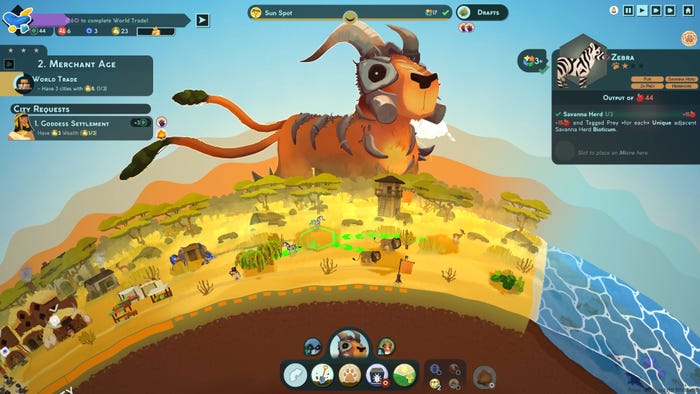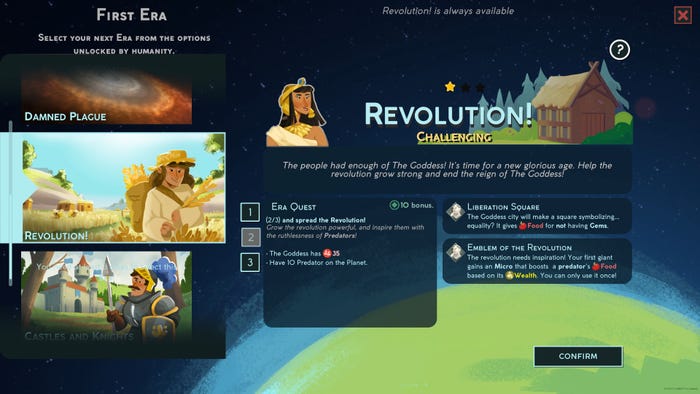Trending
Opinion: How will Project 2025 impact game developers?
The Heritage Foundation's manifesto for the possible next administration could do great harm to many, including large portions of the game development community.
Abbey Games' Adriaan Jansen discusses how this sequel was born from the studio reaching its lowest point and the design constraints and technical limitations they worked through to get it out the door.

Reus 2 guides giant gods as they reshape worlds and guide ecosystems to help lead human civilization to greener futures on their own planet or to find prosperity (or spread darkness) to the stars.
Game Developer caught up with Adriaan Jansen, one of the co-founders of the game’s development studio, Abbey Games, to talk about how this sequel was born from the studio reaching its lowest point, the challenges of giving the player creative potential to alter the world within a 2D space, and how they had to carefully work within constraints and limitations to get this sequel out the door.
Game Developer: Reus 2 sees players affecting the growth of human civilization through acting as powerful, world-shaping gods. What appealed to you about giving players the power of gods to alter the course of humanity?
Jansen: Peter Molyneux is an important part of it! But most importantly, I just have a lot of love for our planet. It's not just the nature that I love, it's also history, and us humans. I love reading about cultures, histories, and how they interact with humans. I also love the bizarre yet efficient ways of nature, like how all clown fishes are born male, with the most dominant turning female after a fight. All of it is beautiful. It's also an idiotically big subject, and a god game allows us to touch all of that (which we realized when we finished the game).
The original Reus came out over a decade ago. What interested you in coming back to do a sequel? What new things did you want this game to do?
I think the answer depends on whom you ask at Abbey Games. Personally, as the person mainly responsible for the game design, I knew Reus could be so much more. I'm not a "dream game" builder. I just want to see games come alive as the best versions of themselves possible. I'm extremely proud of the result in that regard.
In the team as whole, there were also other powers at play. When we started preproduction of Reus 2, Abbey Games was probably at its lowest point ever. We lost 75% of our team. It was a way for us to regain confidence. We looked at each other and went: "We must be able to do this, right?... right?!" The power of the IP was also an important factor, given that over the decade, more than a million people have bought Reus. That was something we could build on.

Images via Firesquid.
Why did you choose to have the game play out in a 2D sidescrolling perspective? What benefits and drawbacks did this perspective have on how you could design the game and gameplay?
It was less of an idea and more of a premise, really! It creates a unique screenshot that is immediately intuitive. However, there are actually many drawbacks. Technically, it's quite a feat to make that round planet so malleable and natural as it is. The direct cost is already high. It also has huge secondary costs because you set a hard limit to what you can realistically do with the gameplay. You only have a small strip of land where gameplay is done. It's a bit like somebody giving you a gorgeous chessboard with a high fantasy theme, then sawing off all but the last two rows and telling you, "Now make an immersive high fantasy game". And no matter how good of a job we do, the abstraction of space itself limits the game a lot, which makes me even prouder of the result.
What thoughts went into designing the gods and their abilities in the game?
This is, oddly enough, more of a production issue. The giants tie all the elements together, representing a biome as well as the placement of specific types of nature. So, when designing a giant and its abilities, I'm 100% constrained by what we can make. I don't think we got even 50% out of the potential from the giants simply because we didn't manage the interactivity space where those abilities would fall. For example, The Rock giant would love to have an earthquake ability. But what for? There is no war. There are no enemies. And the biome building surely doesn't need another layer of multipliers and buffs. The same could be said about all human-giant interactions. We see this as the biggest missed opportunity, one we wish to rectify.

Images via Firesquid.
How did you design the visuals for the varied gods? What feelings did you want to evoke with the look of these creatures?
We had some constraints, but honestly, they just needed to look cool and harmonized. At first, we did not want them to look too much like animals, but then we got a giant crab, frog, and monkey. They also couldn't be too human—but then we have a bearded ice guy.
It's a fantastic garden, and I like it for its richness.
What thoughts went into creating connections between the various things the gods could do and create and into developing synergies that could lead humanity in all sorts of directions?
Too many! The hard part was where to draw the line. You can't model the world; you have to pick your abstractions. In the end, we laser-focused on having fun, synergetic gameplay and let the humans react to it as a secondary. In a way, we didn't have a choice: many aspects of humans interacting with nature or each other were just not coming together quickly and we had to abandon them.

Images via Firesquid.
When your god changes a part of the world, the visuals smoothly show the transition between its old state and the new one. How did you design these visual transitions so that players could watch the land change in such a striking way?
We knew this was important from the original Reus, so we put a good amount of effort into keeping this intact. It was some iterative work, but we had good constraints to work from.
How did you design systems that would lead humanity down different paths depending on how the gods shaped their world? How did this kind of narrative weave into the player's choices in what animals and terrain to populate the world with?
Actually, chatGTP was quite useful here! We were looking for nature-human relationships, and polling Google or Wikipedia is a lot of work. So, we asked AI to give us examples: what are plants, animals, or minerals used by humans throughout history to gain prosperity? Then we only needed to fact check, instead of finding an obscure blog list somewhere to draw inspiration from. In the end, it was very welcome help; it allowed us to scale up the number of natural elements to almost 300 pieces! Then, we could just pick examples of human inventions or turning points.

Images via Firesquid.
What paths did you want to create for humanity? What thoughts went into creating the various ways humanity can change over the course of the game (becoming spacefarers, starting cults, etc)?
Here, we were obviously limited by our capabilities because we had ideas to spare. We went with a few more visually explosive ones like the ones you mentioned, but we also needed some more basic ones. Who knows what we might add in the future?
What ideas went into the various planets players could start off with? How did you design worlds that would create interesting challenges and benefits for the player and their choice of god?
This was actually the hardest part to get right in the end. We had so many constraints: the villages, the biomes, the giants... getting them all to work together smoothly retroactively was a lot of work. We also faced our limitations with what we could do, too, especially with the cities and the giants. The key was to keep it simple. Some players have noticed that the giants don't take up much of the design space, and they're right. In the end, it fell off a little because of the other limitations we had. Although we have some plans moving forward! The game is doing well, and we're looking forward to expand on the universe.
You May Also Like